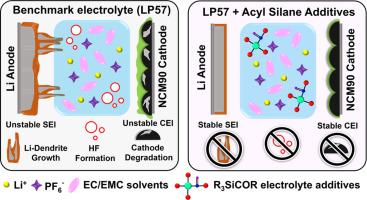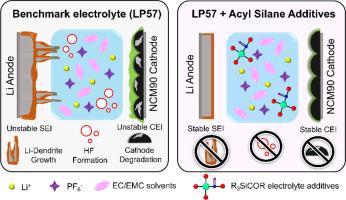Tuning additive functionality via a molecular-by-design strategy: Acyl silanes for stable high-nickel cobalt-lean cathodes in lithium-based batteries
IF 20.2
1区 材料科学
Q1 CHEMISTRY, PHYSICAL
引用次数: 0
Abstract
Developing multifunctional electrolyte additives is essential for stabilizing high-nickel cobalt-lean cathodes, which are prone to interphase instability and parasitic side reactions, particularly at elevated voltages. Herein, a molecular-by-design strategy is presented that enables systematic tuning of interphase chemistry and hydrofluoric acid (HF) scavenging capability via single-bond (Si–X, X = Me, Me2N, F) variation within an acyl silane framework. Three structurally analogous yet functionally distinct additives were synthesized: di-tert-butyl methyl adamantoyl silane ((Me)tBu2SiCOAd; Ad is 1-Ad), (di-methyl amino) di-tert-butyl adamantoyl silane ((Me2N)tBu2SiCOAd), and di-tert-butyl fluoro adamantoyl silane ((F)tBu2SiCOAd). In Li||LiNi0.9Co0.05Mn0.05O2 (Li||NCM90) cells with carbonate-based electrolyte, (Me2N)tBu2SiCOAd, significantly improves cycling stability, delivering 90 % capacity retention after 200 cycles at 1C and 4.3 V (30 % improvement over the blank), and 80 % retention at 4.4 V (42 % improvement). This enhancement is attributed to its multifunctionality: stable interphase formation and effective HF scavenging via the Si-N bond. Conversely, (Me)tBu2SiCOAd contributes only to interphase formation, while (F)tBu2SiCOAd is ineffective. These findings are supported by theoretical simulations, which reveal a low activation barrier for HF scavenging by (Me2N)tBu2SiCOAd and explain the inert behavior of (F)tBu2SiCOAd. Overall, this study demonstrates how targeted single-bond modulation enables precise molecular tuning of additive functionality in high-nickel cobalt-lean systems.


通过分子设计策略调整添加剂功能:用于锂基电池中稳定的高镍钴贫阴极的酰基硅烷
开发多功能电解质添加剂对于稳定高镍钴贫阴极至关重要,因为高镍钴贫阴极容易发生相间不稳定和寄生副反应,特别是在高电压下。本文提出了一种分子设计策略,通过在酰基硅烷框架内的单键(Si-X, X = Me, Me2N, F)变化,可以系统地调整相间化学和氢氟酸(HF)清除能力。合成了三种结构相似但功能不同的添加剂:二叔丁基甲基金刚烷硅烷((Me)tBu2SiCOAd;Ad为1-Ad)、(二甲基氨基)二叔丁基金刚烷基硅烷((Me2N)tBu2SiCOAd)和二叔丁基氟金刚烷基硅烷((F)tBu2SiCOAd)。在含有碳酸盐电解质(Me2N)tBu2SiCOAd的Li||LiNi0.9Co0.05Mn0.05O2 (Li||NCM90)电池中,循环稳定性显著提高,在1C和4.3 V下循环200次后,容量保持率达到90%(比空白提高30%),在4.4 V下保持率达到80%(提高42%)。这种增强归因于其多功能性:稳定的间相形成和通过Si-N键有效清除HF。相反,(Me)tBu2SiCOAd只对间相形成有贡献,而(F)tBu2SiCOAd没有作用。这些发现得到了理论模拟的支持,理论模拟揭示了(Me2N)tBu2SiCOAd清除HF的激活屏障较低,并解释了(F)tBu2SiCOAd的惰性行为。总体而言,本研究证明了靶向单键调制如何能够在高镍钴贫系统中实现添加剂功能的精确分子调谐。
本文章由计算机程序翻译,如有差异,请以英文原文为准。
求助全文
约1分钟内获得全文
求助全文
来源期刊

Energy Storage Materials
Materials Science-General Materials Science
CiteScore
33.00
自引率
5.90%
发文量
652
审稿时长
27 days
期刊介绍:
Energy Storage Materials is a global interdisciplinary journal dedicated to sharing scientific and technological advancements in materials and devices for advanced energy storage and related energy conversion, such as in metal-O2 batteries. The journal features comprehensive research articles, including full papers and short communications, as well as authoritative feature articles and reviews by leading experts in the field.
Energy Storage Materials covers a wide range of topics, including the synthesis, fabrication, structure, properties, performance, and technological applications of energy storage materials. Additionally, the journal explores strategies, policies, and developments in the field of energy storage materials and devices for sustainable energy.
Published papers are selected based on their scientific and technological significance, their ability to provide valuable new knowledge, and their relevance to the international research community.
 求助内容:
求助内容: 应助结果提醒方式:
应助结果提醒方式:


